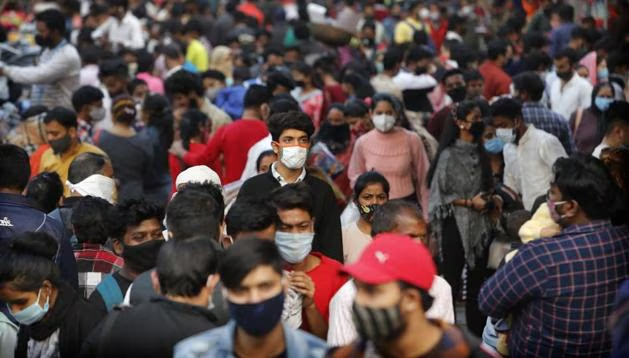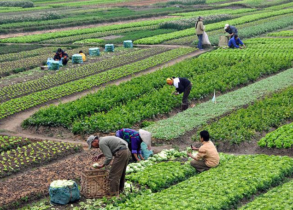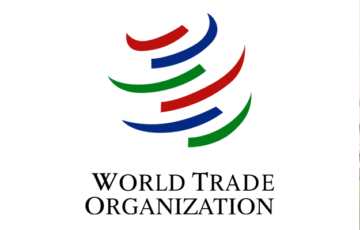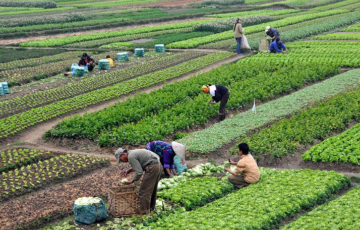HUMAN DEVELOPMENT IN INDIA
Meaning of Human Development
- Human development represents a comprehensive and multidimensional approach to enhancing the well-being and freedoms of individuals, transcending the traditional reliance on economic growth as a sole indicator of progress. It prioritizes the expansion of people’s choices and capabilities, offering them the opportunity to lead fulfilling lives according to their desires and values. This expansion encompasses a broad spectrum of possibilities, from health and education to political freedom and dignity.
Dimensions of Human Development
- Human development is underpinned by several key dimensions that collectively contribute to its overarching goal of improving human well-being and freedom.
- Productivity: Productivity is a crucial dimension focusing on enhancing the efficiency and output of human labor. Improving productivity involves investing in education and health to equip individuals with the knowledge and well-being necessary for increased productivity, which, in turn, can fuel economic and social progress.
- Equity: Equity ensures that all individuals have equal opportunities to access resources and opportunities, regardless of gender, ethnicity, income, or social status. It aims to dismantle barriers that prevent people from realizing their full potential, thereby fostering a more inclusive and fair society.
- Sustainability: Sustainability emphasizes the importance of meeting the needs of the present without compromising the ability of future generations to meet their own needs. It seeks a balance between economic growth, environmental conservation, and social equity, promoting practices that ensure long-term planetary health and resource availability.
- Empowerment: Empowerment focuses on giving individuals the ability to take control over their lives. It involves creating environments where people are respected, confident, and able to participate fully in their communities. Empowerment is crucial for fostering equality and enabling individuals to contribute to societal development.
Measuring Human Development
- Human development encompasses the improvement of people’s well-being, focusing on enhancing their capabilities to lead long, healthy, educated, and prosperous lives. Recognizing the multidimensional nature of human development, the United Nations Development Programme (UNDP) annually publishes the Human Development Index (HDI) since the 1990s. Developed by economists Amartya Sen and Mehboob Ul Haq, the HDI serves as a composite metric to evaluate and rank countries based on their social and economic progress.
Human Development Index (HDI)
- The HDI is a cornerstone in measuring human development, reflecting a country’s average achievements in three fundamental aspects:
- A Healthy and Long Life: Measured by life expectancy at birth.
- Access to Knowledge: Evaluated through expected years of schooling and mean years of schooling.
- A Decent Standard of Living: Assessed by gross national income per capita, adjusted for purchasing power parity (PPP).
- The HDI values range from 0 to 1, categorizing countries into four tiers: Very High (0.80 and above), High (0.70 to 0.79), Medium (0.550 to 0.699), and Low (below 0.550).
- In addition to the HDI, other indices provide a more nuanced view of human development challenges, including the Inequality-adjusted HDI (IHDI), Gender Development Index (GDI), Gender Inequality Index (GII), and Multidimensional Poverty Index (MPI).
Criticisms of HDI
- Implicit Assumptions: The HDI assumes a balance between its components (life expectancy, education, and GNI per capita), which may not equally contribute to human development across different contexts.
- Responsiveness to Policy Changes: The HDI may not quickly reflect short-term policy impacts, focusing more on long-term development indicators like life expectancy.
| Merits | Demerit |
| · It has both economic and social indicators and hence it is multidimensional.
· It focuses on the ultimate objective of development and helps understand the meaning of development better. |
· It does not include gender issues and discrimination.
· It does not include income inequality, political rights and freedom. · It doesn’t include environmental indicators. |
Challenges for India in Human Development
- Low Gross Enrolment Ratio: High school dropout rates limit economic growth and innovation, driven by financial constraints, lack of interest, and the need for children to work.
- Education Infrastructure: Quality education is hindered by inadequate infrastructure, including classrooms, sanitation, digital learning, and sports facilities.
- Gender Inequality: Persistent gender stereotypes and limited upward mobility for women result in a low female labor force participation rate.
- Healthcare Facilities: Significant disparities in healthcare quality and accessibility between rural and urban areas, and public and private providers, exacerbate health inequalities.
- Malnutrition: A major issue due to poverty, inequality, and food insecurity, significantly impacting India’s human development and child mortality rates.
- Inadequate Social Security: Most workers in India’s informal sector lack access to social security, affecting their well-being and economic stability.
Multidimensional Poverty Index (MPI)
- The MPI, developed by the United Nations Development Programme (UNDP) and the Oxford Poverty and Human Development Initiative (OPHI), is an international measure of acute multidimensional poverty across over 100 developing countries. Launched in 2010, it assesses deprivations across health, education, and standard of living.
Indicators and Measurement
- The MPI tracks ten indicators, considering both the incidence (the proportion of people who are multidimensionally poor) and the intensity (the average proportion of indicators in which poor people are deprived) of poverty. A person is deemed multidimensionally poor if they are deprived in 33% or more of the weighted indicators.
Inequality-adjusted Human Development Index (IHDI)
- Since 2010, the UNDP has published the IHDI, which integrates inequality into the traditional Human Development Index by accounting for disparities in health, education, and income among a country’s citizens. This index provides a more accurate reflection of the actual human development levels by considering how these achievements are distributed.
Genuine Progress Indicator (GPI)
- The GPI is a metric proposed as an alternative to GDP, focusing on sustainable and welfare economics. It aims to more reliably differentiate between beneficial and harmful economic growth.
- The GPI is based on:
- Accounting for income inequality.
- Including non-market benefits not captured by GDP.
- Deducting negative aspects such as environmental degradation and loss of leisure time.
Social Progress Index
- Created by the Social Progress Imperative NGO, this index measures a country’s social and environmental performance independently of economic parameters. It emphasizes that real progress is not adequately captured by monetary metrics alone and ranks countries using 51 indicators across various dimensions of well-being.
Gross National Happiness Index
- Coined by Bhutan’s King Jigme Singye Wangchuk in the 1970s, Gross National Happiness (GNH) proposes a holistic approach to development, prioritizing non-economic aspects of well-being.
- GNH is based on four pillars:
- Good governance.
- Sustainable socio-economic development.
- Cultural preservation.
- Environmental conservation.
World Happiness Report
The complex landscape of global happiness, gender equality, and human capital development is extensively analyzed through various indexes and reports. These tools provide critical insights into the state of societies worldwide, guiding policies and interventions.
- Publisher: United Nations Sustainable Development Solutions Network annually.
- Objective: Compares and ranks 146 countries based on citizens’ perceived happiness.
- Methodology: Utilizes Gallup World Poll data, focusing on six key variables: GDP per capita, social support, healthy life expectancy, freedom to make life choices, generosity, and perceptions of corruption.
Human Capital vs Human Development
| Aspect | Human Capital | Human Development |
| Core Focus | Concentrates on enhancing education and health to increase labor productivity. | Focuses on improving human well-being, viewing education and health as fundamental to enabling individuals to make valued choices. |
| View of Individuals | Regards individuals primarily as means to achieve higher productivity and economic growth. | Considers individuals as ends in themselves, emphasizing their intrinsic value beyond economic contributions. |
| Underlying Philosophy | Operates under the economic principle that investing in human capabilities (like education and health) will yield returns in terms of increased labor productivity. | Rooted in the belief that every person has the right to live a fulfilling life, with access to education and health care as basic necessities that enable other choices. |
| Scope | A narrower concept that focuses specifically on the economic value of investing in human capabilities. | A broader concept that encompasses a wide range of human aspirations and the conditions necessary for a fulfilling life, beyond just economic metrics. |
| End Goal | The ultimate aim is to enhance economic efficiency and growth through a more productive workforce. | Aims to ensure a high quality of life for people, promoting equitable access to opportunities and choices in various aspects of life. |
Demographic Dividend
- The demographic dividend refers to the economic growth potential that arises from changes in a population’s age structure, particularly when the working-age population (15 to 64 years) surpasses the dependent population (those below 14 and above 65 years). This phenomenon has historically led to significant economic booms, as seen in the “Asian economic miracle” of the late twentieth century. India, with its large youth population, stands to benefit from the demographic dividend, but it also faces various challenges and opportunities in maximizing its potential.
Status of Demographic Dividend in India
Youth Population
- India boasts the largest youth population globally, with approximately 66% of its total population below the age of 35. The country’s median age is significantly lower compared to other major economies like the US, China, and Japan, indicating a substantial working-age population.
Demographic Transition
- India’s demographic transition is underway, with declining birth rates and increasing life expectancy leading to a bulge in the working-age population. This demographic trend is projected to last until 2055, providing a considerable window of opportunity for economic growth.
Differential Regional Dynamics
- The demographic dividend manifests differently across states due to variations in population parameters. While some states may experience the dividend earlier, others may lag behind, highlighting the need for tailored policy interventions at the regional level.
Benefits of Demographic Dividend
Economic Growth
- A larger working-age population drives increased economic activity, contributing to higher GDP growth rates. Historically, the demographic dividend has accounted for up to 15% of overall growth in advanced economies.
Productive Labor Force
- With fewer children per household, there is a higher investment per child, resulting in a more skilled and productive workforce in the future.
Women’s Empowerment
- Reduced fertility rates often lead to greater opportunities for women to participate in the formal workforce, fostering economic empowerment and growth.
Increase in Savings and Investments
- The working-age population tends to have higher savings rates, which can be channeled into investments, fueling further economic expansion.
Rise of Middle Class
- Effective utilization of the demographic dividend can lead to the emergence of a burgeoning middle class, driving consumption and economic prosperity.
Rapid Industrialization and Urbanization
- A large young population creates demand for goods and services, fostering industrialization and urban development.
Boost to Innovation and Entrepreneurship
- A youthful demographic profile promotes innovation and entrepreneurship, vital for sustaining economic growth in a rapidly evolving global landscape.
Challenges Related to the Demographic Dividend
Rising Unemployment
- Ensuring adequate job creation for the burgeoning workforce is essential to realize the full potential of the demographic dividend.
Skills Gap
- The mismatch between the skills possessed by the workforce and those demanded by the labor market poses a significant challenge to leveraging the demographic dividend effectively.
Low Human Development Parameters
- India’s poor rankings in human development indicators underscore the need for substantial investments in health and education to enhance workforce productivity.
Informal Economy
- The prevalence of informal employment structures hampers efforts to harness the demographic dividend, necessitating reforms to formalize the labor market.
Regional Disparities
- The uneven distribution of demographic transition across states exacerbates regional disparities, requiring targeted interventions to ensure inclusive growth.
Measures to Overcome Challenges
Job Creation
- Policies promoting business growth and entrepreneurship are crucial for generating employment opportunities.
Skill Development
- Investments in skill development programs are essential to enhance the employability of the workforce and bridge the skills gap.
Health and Education Investments
- Increased spending on healthcare and education is vital to improving human capital and workforce productivity.
Gender Equality
- Efforts to promote gender parity in education and workforce participation are essential for harnessing the full potential of the demographic dividend.
Regional Development Initiatives
- Tailored policies addressing regional disparities in demographic transition and economic development are necessary for inclusive growth.
Urban Planning
- Urban development strategies must prioritize infrastructure and social services to accommodate the influx of young migrants into urban areas.
Federal Cooperation
- Effective coordination between the central and state governments is critical for formulating and implementing policies to maximize the benefits of the demographic dividend.
UPSC PREVIOUS YEAR QUESTIONS
1. Despite the Consistent experience of high growth, India still goes with the lowest indicators of human development. Examine the issues that make balanced and inclusive development elusive. (2016)
2. The Multidimensional Poverty Index developed by Oxford Poverty and Human Development Initiative with UNDP support covers which of the following? (2012)
1. Deprivation of education, health, assets and services at household level
2. Purchasing power parity at national level
3. Extent of budget deficit and GDP growth rate at national level
Select the correct answer using the codes given below:
(a) 1 only
(b) 2 and 3 only
(c) 1 and 3 only
(d) 1, 2 and 3










